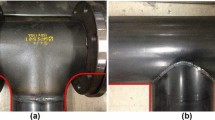Abstract
This paper presents a low-cost pipeline surface 3D detection method based on line structured light. The method adds 3D detection to the robot at a meager cost and change. The optical flow method is used to derive the motion information of the robot to replace the motion closed loop. Finally, the depth data for the entire surface are generated automatically only from the camera and the line laser projector, without using other devices. In addition, a novel spot centroid extraction algorithm based on the color region of interest and an adaptive threshold is presented. This method can accurately detect the laser centroid in the pipeline surface. We conducted experiments with a quadruped robot and validated algorithms. The experimental results show that the proposed method achieves 3D detection on a trackless robot at a meager cost and is superior to standard depth sensors.



















Similar content being viewed by others
Data availability
All data are original for this study, and none has been published elsewhere.
References
Wang, T., Tan, L., Xie, S., et al.: Development and applications of common utility tunnels in China. Tunn. Undergr. Space Technol. 76, 92–106 (2018)
Zhou, R., Fang, W., Wu, J.: A risk assessment model of a sewer pipeline in an underground utility tunnel based on a Bayesian network. Tunn. Undergr. Space Technol. 103, 103473 (2020)
Shang, Z., Shen, Z.: Single-pass inline pipeline 3D reconstruction using depth camera array. Autom. Constr. 138, 104231 (2022)
Li, Y., Wang, H., Dang, L.M., et al.: A robust instance segmentation framework for underground sewer defect detection. Measurement 190, 110727 (2022)
Halfawy, M.R., Hengmeechai, J.: Efficient algorithm for crack detection in sewer images from closed-circuit television inspections. J. Infrastruct. Syst. 20(2), 04013014 (2014)
Laga, H., Jospin, L.V., Boussaid, F., et al.: A survey on deep learning techniques for stereo-based depth estimation. IEEE Trans. Pattern Anal. Mach. Intell. (2020). https://doi.org/10.1109/TPAMI.2020.3032602
Poggi, M., Tosi, F., Batsos, K., et al.: On the synergies between machine learning and binocular stereo for depth estimation from images: a survey. IEEE Trans. Pattern Anal. Mach. Intell. 44(9), 5314–5334 (2021)
Mansour, M., Davidson, P., Stepanov, O., et al.: Relative importance of binocular disparity and motion parallax for depth estimation: a computer vision approach. Remote Sens. 11(17), 1990 (2019)
Priya, L., Anand, S.: Object recognition and 3D reconstruction of occluded objects using binocular stereo. Cluster Comput. 21(1), 29–38 (2018)
Van der Jeught, S., Dirckx, J.J.J.: Real-time structured light profilometry: a review. Opt. Lasers Eng. 87, 18–31 (2016)
Yang, L., Liu, Y., Peng, J.: Advances techniques of the structured light sensing in intelligent welding robots: a review. The Int. J. Adv. Manuf. Technol. 110(3), 1027–1046 (2020)
Xu, X., Fei, Z., Yang, J., et al.: Line structured light calibration method and centerline extraction: a review. Res. Phys. 19, 103637 (2020)
Liang, J., Gu, X.: Development and application of a non-destructive pavement testing system based on line structured light three-dimensional measurement. Constr. Build. Mater. 260, 119919 (2020)
Yu, H., Huang, Y., Zheng, D., et al.: Three-dimensional shape measurement technique for large-scale objects based on line structured light combined with industrial robot. Optik 202, 163656 (2020)
Shang, Z., Wang, J., Zhao, L., et al.: Measurement of gear tooth profiles using incoherent line structured light. Measurement 189, 110450 (2022)
Sipiran, I., Bustos, B.: Harris 3D: a robust extension of the Harris operator for interest point detection on 3D meshes. Visual Comput. 11(27), 963–976 (2011)
Baker, S., Matthews, I.: Lucas-kanade 20 years on: a unifying framework[J]. Int. J. Comput. Vision 56(3), 221–255 (2004)
RICHO.: Imaging performance without compromise. https://www.ricoh-imaging.co.jp/english/products/gr-3/feature/, 2019
Intel.: Tech Specs, https://www.intelrealsense.com/depth-camera-d455/, 2020
Funding
The authors did not receive support from any organization for the submitted work.
Author information
Authors and Affiliations
Contributions
T.L. did most of the work and wrote the main manuscript; G.Y. set up the experimental environment and modified the manuscript. All authors reviewed the manuscript.
Corresponding author
Ethics declarations
Conflict of interest
The authors have no relevant financial or non-financial interests to disclose.
Informed consent
No conflict of interest exists in the submission of this manuscript, and all authors approve the manuscript for publication.
Additional information
Publisher's Note
Springer Nature remains neutral with regard to jurisdictional claims in published maps and institutional affiliations.
Rights and permissions
Springer Nature or its licensor (e.g. a society or other partner) holds exclusive rights to this article under a publishing agreement with the author(s) or other rightsholder(s); author self-archiving of the accepted manuscript version of this article is solely governed by the terms of such publishing agreement and applicable law.
About this article
Cite this article
Lan, T., Yang, G. A low-cost pipeline surface 3D detection method used on robots. SIViP 18, 3915–3924 (2024). https://doi.org/10.1007/s11760-024-03052-0
Received:
Revised:
Accepted:
Published:
Issue Date:
DOI: https://doi.org/10.1007/s11760-024-03052-0




